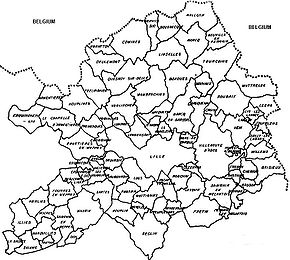- Urban Community of Lille Métropole
-
Lille Métropole
Communauté urbaine

LogoCountry France Region Nord-Pas de Calais Department Nord No. of communes 85 Established December 22, 1967 Seat Lille Government – President Martine Aubry (PS) – Term of office 2008-present Area – Total 611.45 km2 (236.1 sq mi) Population (1999) – Total 1,091,438
(19.5% in the city of Lille)– Density 1,785/km2 (4,623.1/sq mi) Budget 1,441 Millions € (2006)¹ Website Lille Métropole
Communautés Urbaines¹ Source for the budget The Urban Community of Lille Métropole (French: Lille Métropole Communauté Urbaine) is the intercommunal structure gathering the commune of Lille and that part of the Lille metropolitan area that lies in France.
The goal of the Urban Community is to build a better metropolitan area by synchronizing the transport system, environmental actions, etc.
Contents
History
The Urban Community was founded in 1967, its first president was Augustin Laurent. Then, in 1971, Arthur Notebart, Deputy Mayor of Lomme succeeded him until the election of Pierre Mauroy in 1989. After the March 2008 municipal elections, each city council will send delegates to the urban community, a total of 170 voting members. In April 2008, the new president will be elected on a majority vote defined at 816 votes. It will be a cause for intense lobbying throughout the 85 cities and villages. One key issue will be on the investment priorities for the 2008/2014 period, namely Transport, Housing and the Environnement. Newly re-elected mayor of Lille, socialist Martine Aubry, will try to impose a new 800m euro stadium in the eastern part of the community, which is opposed by three major mayors of her own party, who consider the project as misplaced and too expensive.
Responsibilities
Local public transport
Main article: TranspoleThe urban community is responsible for the co-ordination of Transpole, the private sector company that operates a public transport network throughout the Métropole. The network comprises buses, trams and a driverless metro system, all of which are operated under the Transpole name. The Lille Metro is a VAL system (véhicule automatique léger = light automated vehicle) that opened on May 16, 1983, becoming the first automatic metro line in the world. The metro system has two lines, with a total length of 45km and 60 stations. The tram system consists of two interurban tram lines, connecting central Lille to the nearby communities of Roubaix and Tourcoing, and has 45 stops. 68 urban bus routes cover the metropolis, 8 of which reach into Belgium.[1]
Cross-border issues
The Urban Community of Lille Métropole encompasses only the French part of the metropolitan area of Lille. The other part of the metropolitan area is on Belgian territory (Mouscron, Kortrijk, Ypres, Roeselare, etc.) and outside of the scope of the Urban Community. There are currently some projects to establish an Urban Community for the whole metropolitan area, crossing borders, but this transnational structure has not been created yet.
Communes
The 85 communes of the Urban Community are:
References
- ^ "Travel & Transport". La mairie de Lille. http://www.mairie-lille.fr/sections/site-en/Lille_pratique/travel-transport. Retrieved 2008-02-18.
External links
Categories:- Metropolitan areas of France
- Urban communities in France
- Arrondissement of Lille
Wikimedia Foundation. 2010.
